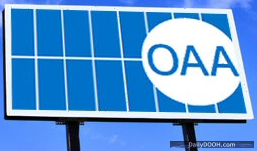Where The OAAA Money Went
Gail Chiasson, North American Editor
Following up on our short article with regard the Washington, D.C.-based Outdoor Advertising Association of America’s expenditures on lobbying, we were interested to see that the OAAA has released its extensive and interesting 2011 Annual Report in which a section is devoted to legislation – achieved or not – regarding the outdoor advertising scene.
 We also noticed that the outdoor industry increased its political giving to federal candidates by 50% in 2011 compared to the previous year.
We also noticed that the outdoor industry increased its political giving to federal candidates by 50% in 2011 compared to the previous year.
On the legislative front, 2011 was a successful year for the outdoor advertising industry, with, among others, voters overwhelmingly rejecting a billboard tax in West Hollywood (after the OAAA staff joined the well-organized coalition in opposition of the tax by walking door to door encouraging citizens to vote); Congress leaving the Highway Beautification Act intact; the industry achieving hard-fought victories at the state level; and government expanding its use of out-door advertising to communicate with the public on behalf of safety.
Congress considered highway legislation, but left billboards alone.
“There was peace in Congress, thanks to effective industry advocacy,” says Nancy Fletcher, OAAA president and CEO, in the report. “In general, Congress sees the outdoor industry as a responsible corporate citizen that supports jobs and commerce.”
Unable to adopt a long-term Highway Bill, Congress has extended the current bill through Mar./12. The US Senate favors a two-year Highway Bill, while the House of Representatives supports a six-year bill. Current law requires that states spend 10% of their federal highway funds on transportation enhancements, which are 12 categories including billboard inventory, removal, and control – a category for which states rarely opt to use federal funds.
In another area, in April, the Federal Highway Administration told states not to allow renewable energy devices, such as solar panels or wind turbines, on nonconforming billboards. After OAAA objection directly to FHWA Administrator Victor Mendez, FHWA reversed course, agreeing renewable energy devices are suitable for nonconforming billboards.
An international FHWA-sponsored scan to explore billboard regulations in Australia, Sweden, the Netherlands, and the United Kingdom, begun in 2010, was suspended following questions about wasteful spending and FHWA withdrew federal funding for post-scan research on topics such as state billboard permit fees and permit criteria.
FHWA has been studying traffic safety and digital billboards, having collected eye-glance data during test drives in two markets in 2009 and 2010. While FHWA has not yet released its findings, OAAA is continually monitoring progress,
The report notes that the FBI and the US Marshal’s Service have used digital billboards to successfully locate 45 fugitives in the past year, while the Federal Emergency Management Administration delivered disaster information, and the National Center for Missing & Exploited Children continues to display Amber Alerts.
A National Highway Traffic Safety Administration report in July that found a project, to crack down on texting and phoning while driving, produced significant results in Hartford, CT. The government’s paid media mix in Hartford included digital billboards.
In other various state news, Oregon adopted legislation to allow digital billboards in 2011; New Mexico and South Dakota rejected anti-digital proposals; Arkansas and Montana considered but did not approve anti-outdoor lighting legislation; and Georgia and North Carolina approved long-sought vegetation control measures.
In other sections of the report, we noted that, among other facts:
- The OAAA conducted a series of roadshows during September and October providing a comprehensive overview about out- of-home advertising to more than two dozen media planning and strategy groups at major ad agencies and for national brands;
- At the OAAA/TAB National Convention and Trade Show in Miami, more than 1,000 outdoor advertising professionals benefited from three days of education, insights, and networking;
- Among several marketing research initiatives during the past year, OAAA worked with Omnicom’s Brandscience to develop research that evaluated out-of-home return on investment. It showed that every dollar spent on out-of-home media produced an average ROI of $2.80 based on a global sample of more than 600 brands. The study also found as the out-of-home proportion in a media mix increases, so do sales;
- OAAA is currently working with Every Child By Two, a nonprofit committed to reducing the burden of vaccine-preventable diseases in children, to develop a ‘Vaccinate Your Baby’ out-of-home campaign, which targets the US with messages about vaccine safety and the importance of vaccinating children. The campaign is expected to launch in January.
One thing we found strange is OAAA’s comment re its repositioning in that it ‘learned that brand positioning is the image that resides in the minds of target customers.’ We’re not quite sure what it thought before and why this is such a change.
However, for those who have time, the full report is well worth a read and can be found here.




Follow DailyDOOH